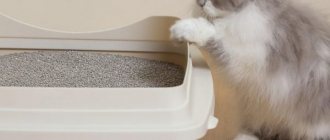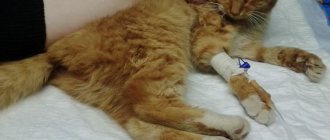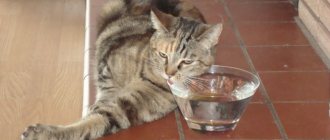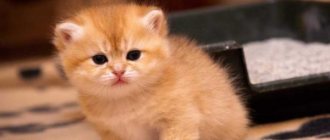A healthy cat with satisfactory maintenance and nutrition pees 3 to 5 times a day. Deviations from this norm may indicate an imbalance in water balance, which is easy to correct. To do this, you need to provide the animal with unhindered access to water at any time of the day.
However, there are accompanying signs that indicate the development of pathologies of the genitourinary system. They lead to difficulty urinating. Every owner should know about these symptoms in order to pay attention in time and provide competent assistance to the pet.
Norms of urination in cats and cats
The number of urinations per day in adult cats and female cats may vary slightly. This is due to the difference in the structure of the genitourinary organs of males and females. Due to the longer and narrower urethra, cats need to pee 3 to 5 times a day.
While cats need 2-3 times a day. This multiplicity does not depend on previous sterilization or castration, so any deviations from the norm should be perceived by the owner as an alarming signal.
Why can't my cat pee?
The reasons why the cat was unable to go to the litter box may be external factors. Usually, after eliminating them at home, the process of urination returns to normal without medical intervention.
These factors include:
- insufficient water consumption;
- prolonged stay in a hot room or outdoors in the summer;
- a sudden change in diet (transferring cats to dry ready-made food);
- moving to a different climate zone;
- stress;
- surgeries on the genitourinary system.
Sometimes a cat cannot pee for a long time after abdominal surgery on the abdominal organs or intestines. This is due to the fact that during the administration of general anesthesia, the animal involuntarily empties the bladder, and the slowdown of all vital processes in the body during anesthesia prevents it from filling quickly.
Important! If two days after castration the cat still cannot pee or the cat does not go to the toilet in a small way, then you should contact a veterinarian.
But there are also pathological reasons that a cat cannot go to the toilet in a small way, in which a person must help the pet.
Urolithiasis disease. This disease often develops in cats that do not receive adequate physical activity, and the basis of their diet is dry food.
When a cat doesn't drink enough and doesn't urinate enough, crystals begin to form in the kidneys, which gradually form into stones. At the first stage of the disease, the animal begins to frequently go to the toilet in small portions, since sand and larger stones constantly irritate the mucous membrane of the bladder and urethra. But at the moment when stones get into the ducts and block them completely, cats cannot go to the toilet in a small way. Urine accumulates in the bladder and, if left untreated, leads to rupture of its walls.
Important! Problems with urination and digestion in cats arise when the owner makes a serious mistake and begins to feed his pet both natural and ready-made food. The imbalance of such a diet also often leads to allergic reactions, hair loss, eczema and other skin diseases.
Cystitis. Inflammatory processes in the bladder in cats and cats in the first phase of development provoke frequent urination and pets can go to the toilet a little every hour. But if left untreated, the disease enters the second phase, in which swelling of the urinary canal prevents the outflow of fluid and the cat cannot pee.
You should not treat cystitis in cats on your own, since the pathology that is not completely cured will constantly manifest itself in relapses. You should also find out the reasons for the development of the disease and its type.
The fact is that the struvite-induced form of cystitis is a harbinger of urolithiasis. Inappropriate treatment in this case will provide temporary relief, but will subsequently lead to the cat being unable to pee due to kidney stones.
Note! Experts identify an idiopathic form of cystitis, which presumably occurs against the background of severe stress. Therefore, if after a stressful situation the cat does not go to the toilet, you should urgently contact a veterinary clinic.
Anomalies of the development of the genitourinary apparatus in cats. Sometimes this pathology manifests itself in the first months of an animal’s life, when the kitten does not go to the toilet very often or the process causes difficulties for him. But there are cases where manifestations of congenital anomalies are observed in pets in adulthood.
At first, the cat begins to rarely go to the toilet in small ways without pain. But hypothermia or bacterial infections can trigger inflammatory swelling, which leads to a lack of urination for 2 or more days.
The reason that cats urinate little may be prostatitis. In the acute form of the disease, there is no full urination, but droplets of bloody discharge appear from the urethra, the animal’s posture indicates severe pain in the abdominal area.
In the chronic form, the cat does not go to the toilet very well, but does not show signs of anxiety.
Important! The risk of developing urolithiasis and other pathologies of the genitourinary system in cats increases after sterilization. Therefore, if a neutered cat cannot pee in the toilet, you should immediately visit a veterinary clinic for catheterization.
Causes
For those of you still here, let me elaborate. First of all, there are several factors that can cause a cat to stop urinating. This includes:
- “simple” cystitis, lower urinary tract disease in cats, idiopathic cystitis - different names for the same condition
- bladder stones
- bladder infection
- bladder tumor
- nerve damage
- damaged pelvis, tail or spine
- urethral obstruction or blocked bladder
Cystitis in cats is the most common cause.
© shutterstock
The main signs of the disease
The main sign that a cat cannot pee is when the animal walks around the tray and meows pitifully. Some owners notice that their pets sometimes behave in this way during heat. But you should distinguish between these reasons in order to promptly help a cat who cannot go to the toilet in a small way at home.
A sick pet exhibits the following clinical signs:
- depressed state;
- unnatural posture with an arched back, a bent neck and knees pushed forward;
- enlargement of the abdomen due to a full bladder;
- decreased or lack of appetite;
- increased body temperature;
- plaintive meowing or screaming during sudden attacks of pain.
If the cat begins to pee a little, then you should pay attention to the quality of the urine. It may change from a light yellow color to an orange or brown tint due to the presence of blood cells. Also, the urine will emit an unpleasant purulent odor, and its structure will become grainy due to crystalline inclusions or sand.
Note! Sometimes a sign that your cat can't pee is stretching out its back legs and licking the genital area for a long time. Also, if it is painful for a cat to go to the toilet in a small way, he lies down near the tray and meows pitifully, demonstrating his problem to the owner.
Behavioral aspect
Well, what could be easier than to explain the behavior of a cat? Unless you prove Fermat's theorem
The main psychological reasons for the uncleanliness of cats:
- Disgust: I don’t like the place where the tray is. Or its filler
- Preference: I like a certain place (oh, but the tray is not there at all!). Or a certain filler (and which one, let the owner guess for himself)
- Insufficient cleanliness of the toilet: the filler must be changed in a timely manner, and the tray must be washed. And preferably with a soap solution, and not a toxic chemical
- Intraspecific aggression: social friction between cats living in the same apartment
- Increased anxiety: stress caused by moving or renovation, the appearance of a new family member or animal, changes in noise or smell, family quarrels, a trip to the clinic, resentment towards the owner, etc. For example, the reason for walking past the potty may be the appearance of a small child in the neighbors' house. Go figure!
If a cat leaves “standard” puddles or piles in the wrong place, then this is most likely a psychological problem. If urination is frequent and in small portions, a doctor is needed. The same thing applies to “unhealthy” stools.
What to do at home if your cat can't pee
The first thing to do if your cat cannot go to the toilet is to take him to the clinic. The doctor will be able to quickly assess the danger of the situation and take radical measures to alleviate the animal’s condition.
First aid
But sometimes circumstances develop in such a way that it is not possible to quickly bring your pet to the hospital. In this case, you should know what to do and how to provide first aid at home to a cat who cannot pee.
To relieve spasm and relax the smooth muscles of the ureters and bladder, male cats should be given an intramuscular injection of No-shpa or Papaverine.
Important! If a cat rarely goes to the toilet or has completely absent urination for more than a day, then giving diuretics is strictly prohibited.
If the cat cannot pee, then as therapy at home you can treat it with Cat Erwin, and also inject it with an antibacterial drug (Tsiprolet, Baytril).
This will help relieve spasm and reduce inflammation for a short period of time. This period should be used to take the cat to the clinic or call a veterinarian at home.
Important! You shouldn’t try to do something on your own if the cat hasn’t been able to pee for 2 days or is screaming in pain or won’t let you touch her belly. In this case, only immediate catheterization can save her from death.
Veterinarian actions
After examining the cat and making a preliminary diagnosis, the veterinarian carries out treatment. It can be roughly divided into 4 stages:
- Preventing stretching and rupture of the bladder in a cat or cat that has not gone to the toilet for more than two days. To do this, a soft catheter with an attached closed system for collecting urine is inserted into the animal. For sterilized cats that periodically cannot pee after castration, a temporary catheter is placed. This is necessary to reduce the risk of developing ascending bacterial infections.
- Stimulation of the bladder muscles. The most effective drug for this is Bethanechol. However, multiple side effects and the need for urgent administration of an antidote in case of intolerance make it possible to use it only in a hospital setting, under the strict supervision of a physician. Cisapride and Propanolol are considered safer drugs for cats. But their independent administration is also prohibited.
- Decreased tone of the urethra and bladder neck. If the obstruction is not associated with anatomical developmental abnormalities, then a cat who has stopped peeing and does not recover for a long time after catheterization is prescribed muscle relaxants (Acepromazine, Diazepam) and alpha-adrenergic antagonists (Phenoxybenzamine, Prazosin).
- Prevention of the development or relief of infectious processes in the lower urinary tract. They often cause systemic inflammation, which can be fatal. Therefore, a veterinarian must prescribe antibacterial drugs to a cat that has not gone to the toilet for the second day or more than 2 days.
Note! The optimal way to select antibiotics is to conduct a preliminary bacteriological study of urine to determine the sensitivity of pathogenic microorganisms to certain drugs. In this case, you can achieve effective results and spend less time treating a cat that cannot pee.
Treatment options
At home, it is impossible to diagnose and carry out full effective treatment for a cat that cannot pee in the litter box on its own. This is due to the fact that in addition to conservative methods of therapy, surgical intervention is often used to eliminate this syndrome.
The most common indications for surgery in cats are malignant and benign tissue growths, as well as urolithiasis. A somewhat less common reason for performing surgery on a cat that rarely goes to the toilet is anatomical anomalies in the structure of the organs of the genitourinary system.
A little about surgical castration
Since this technique is the most common and “typical”, it is necessary to describe it first. Immediately before the procedure, the veterinarian must take all types of tests from the cat in order to understand whether the pet has any systemic diseases or infectious pathologies in which castration is unacceptable.
Based on the data obtained and taking into account the physiological state of the pet, the specialist must decide what type of anesthesia to use in this case: general anesthesia or local anesthesia. As a rule, local anesthesia is used only in the case of very young animals.
Today, experts are increasingly inclined to believe that general anesthesia is necessary for any type of surgical castration.
It is precisely because of the widespread use of general anesthesia that cases of “inappropriate” behavior in sterilized pets are becoming increasingly common. Coming out of anesthesia is a long process and not every cat’s body is able to cope with it quickly. Some cats come to their senses only at the end of the third day (but this still happens rarely).
Special diet
After establishing the reason why the cat cannot pee and carrying out treatment, you should make the right choice of ready-made cat food or change the diet from natural products.
Among industrial cat foods, preference should be given to holistic ones. But the high cost and difficulties in purchasing sometimes become an obstacle for owners. Therefore, they can be replaced with super premium food.
Important! Sometimes owners have a hard time getting their pets to switch to holistic. This is due to the lack of flavor enhancers and flavoring agents that are added to lower class feeds.
In case of urolithiasis, the diet of cats that eat natural food should be adjusted depending on the type of stones. To do this, you need to consult a veterinary nutritionist or attending physician, who will base his recommendations on laboratory data.
| Type of stones | Authorized Products | Prohibited Products |
| Phosphates | rice, buckwheat, oatmeal; | whole milk; |
| boiled beef and rabbit; | hard and fermented milk cheese; | |
| boiled liver | Fish and seafood | |
| Oxolates | boiled carrots, cauliflower; | offal; |
| boiled dietary meat | Fish and seafood; | |
| milk | ||
| Urats | allowed boiled vegetables; | meat and fish broths; |
| lamb, duck, non-lean beef | offal; | |
| lean meat; | ||
| asparagus; | ||
| cauliflower; | ||
| legumes |
For any type of stone, cats can be given pureed baked apples and pears.











